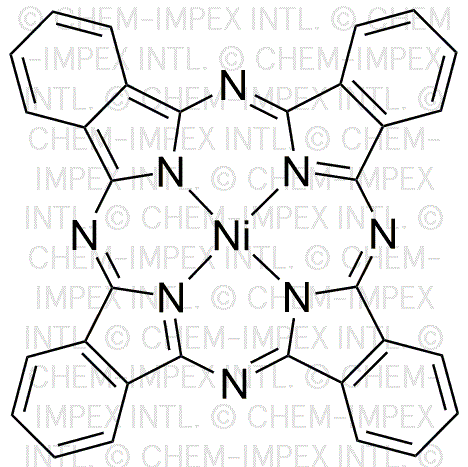Nickel(II) phthalocyanine is widely utilized in research focused on:
- Organic Electronics: This compound is a key material in organic light-emitting diodes (OLEDs) and organic photovoltaics, enhancing device efficiency and stability.
- Catalysis: It serves as an effective catalyst in various chemical reactions, particularly in the production of fine chemicals and pharmaceuticals, improving reaction rates and yields.
- Colorants: Used in the manufacturing of dyes and pigments, it provides vibrant colors for plastics, textiles, and inks, ensuring durability and resistance to fading.
- Electrochemical Applications: Nickel(II) phthalocyanine is employed in sensors and batteries, contributing to improved energy storage and conversion efficiency.
- Environmental Remediation: This compound is utilized in processes for removing pollutants from wastewater, showcasing its effectiveness in reducing environmental impact.
General Information
Properties
Safety and Regulations
Applications
Nickel(II) phthalocyanine is widely utilized in research focused on:
- Organic Electronics: This compound is a key material in organic light-emitting diodes (OLEDs) and organic photovoltaics, enhancing device efficiency and stability.
- Catalysis: It serves as an effective catalyst in various chemical reactions, particularly in the production of fine chemicals and pharmaceuticals, improving reaction rates and yields.
- Colorants: Used in the manufacturing of dyes and pigments, it provides vibrant colors for plastics, textiles, and inks, ensuring durability and resistance to fading.
- Electrochemical Applications: Nickel(II) phthalocyanine is employed in sensors and batteries, contributing to improved energy storage and conversion efficiency.
- Environmental Remediation: This compound is utilized in processes for removing pollutants from wastewater, showcasing its effectiveness in reducing environmental impact.
Documents
Safety Data Sheets (SDS)
The SDS provides comprehensive safety information on handling, storage, and disposal of the product.
Product Specification (PS)
The PS provides a comprehensive breakdown of the product’s properties, including chemical composition, physical state, purity, and storage requirements. It also details acceptable quality ranges and the product's intended applications.
Certificates of Analysis (COA)
Search for Certificates of Analysis (COA) by entering the products Lot Number. Lot and Batch Numbers can be found on a product’s label following the words ‘Lot’ or ‘Batch’.
*Catalog Number
*Lot Number
Certificates Of Origin (COO)
This COO confirms the country where the product was manufactured, and also details the materials and components used in it and whether it is derived from natural, synthetic, or other specific sources. This certificate may be required for customs, trade, and regulatory compliance.
*Catalog Number
*Lot Number
Safety Data Sheets (SDS)
The SDS provides comprehensive safety information on handling, storage, and disposal of the product.
DownloadProduct Specification (PS)
The PS provides a comprehensive breakdown of the product’s properties, including chemical composition, physical state, purity, and storage requirements. It also details acceptable quality ranges and the product's intended applications.
DownloadCertificates of Analysis (COA)
Search for Certificates of Analysis (COA) by entering the products Lot Number. Lot and Batch Numbers can be found on a product’s label following the words ‘Lot’ or ‘Batch’.
*Catalog Number
*Lot Number
Certificates Of Origin (COO)
This COO confirms the country where the product was manufactured, and also details the materials and components used in it and whether it is derived from natural, synthetic, or other specific sources. This certificate may be required for customs, trade, and regulatory compliance.


